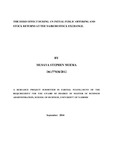| dc.description.abstract | The NSE has witnessed ten IPO in the period 2006-2012. All these IPOs were under priced to
attract investors and despite the discounted prices these primary offers were issued at, investor
scrambled for some while giving a wide berth to others. This research project sought to find out
whether such occurrences could have been explained by herd behaviour. Using daily price data
from NSE I computed the both descriptive and regression analysis of returns to test for the
presence of herding as suggested by Chang, Cheng, and Khorana (2000). The regression
coefficient Y2 was both significant and negative in some IPOs. These were Scan Group Limited,
Safaricom Limited, Eveready Limited and CIC Insurance Group Limited. This was confirmation
of existence of herding during the introductory IPOs of these stocks. Their Post issue return, on
the other hand were negative, effectively signifying herding influenced returns negatively.
However Regression analysis for Kenya electricity generating company Limited, Access Kenya
Limited, Kenya Re-insurance corporation Limited, Centum Investment Limited, British
American Investment limited and CFC Insurance Holdings Limited were in line with their
descriptive statistics. Either their Y2 was not significant or not negative at all indicating no
possible herding during their issue. Their post issue returns ran parallel with the market returns. | en_US |

